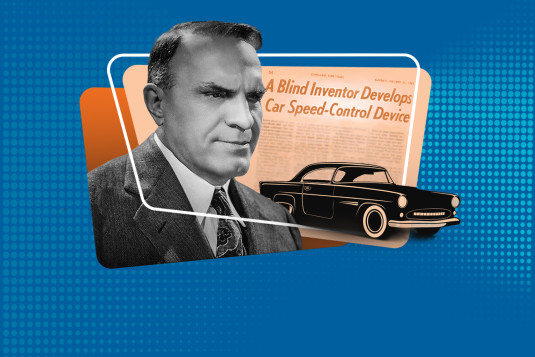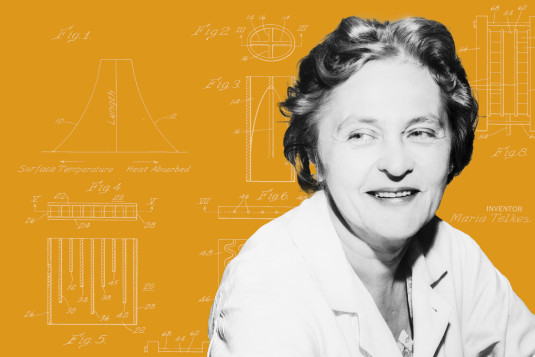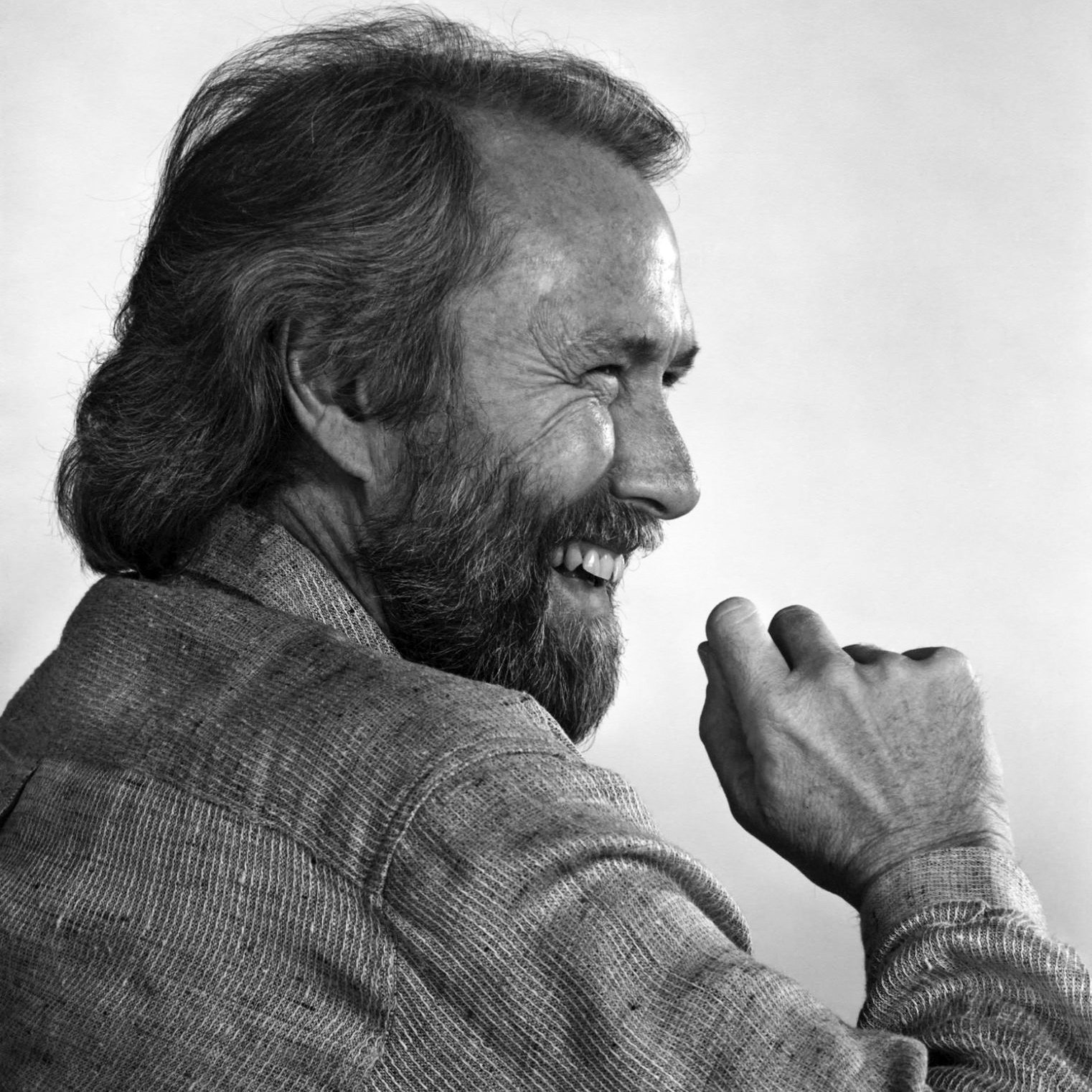
Reframing entertainment
Jim Henson made his first puppet while still in high school—and landed a spot on television because of it. Over the next 36 years, he used his knack for puppeteering, along with his strong ability to collaborate and unique sense of humor, to create a cast of unforgettable characters, leaving a legacy that is still entertaining audiences today.
9 min read
Each month, our Journeys of Innovation series tells the stories of inventors or entrepreneurs who have made a positive difference in the world. This month, we focus on the journey of Jim Henson, who brought us the Muppets.
Most of us know who the Muppets are. We’re familiar with Kermit the Frog and his tempestuous relationship with Miss Piggy. We have visited Sesame Street and spent many hours laughing with Elmo and sympathizing with Cookie Monster. These puppets are as alive to us now as they were when we first met them, and we have Jim Henson’s whimsical imagination and determined creativity to thank.
Henson was born in 1936 in Mississippi but moved to Maryland in the fifth grade. He developed an early interest in art and the television, a recent invention that was quickly gaining popularity by 1950. Enamored with the new device, he immediately saw its unique value. According to Henson, he “loved the idea that what you saw was taking place somewhere else at the same time. It was one of those absolutely wonderful things.”
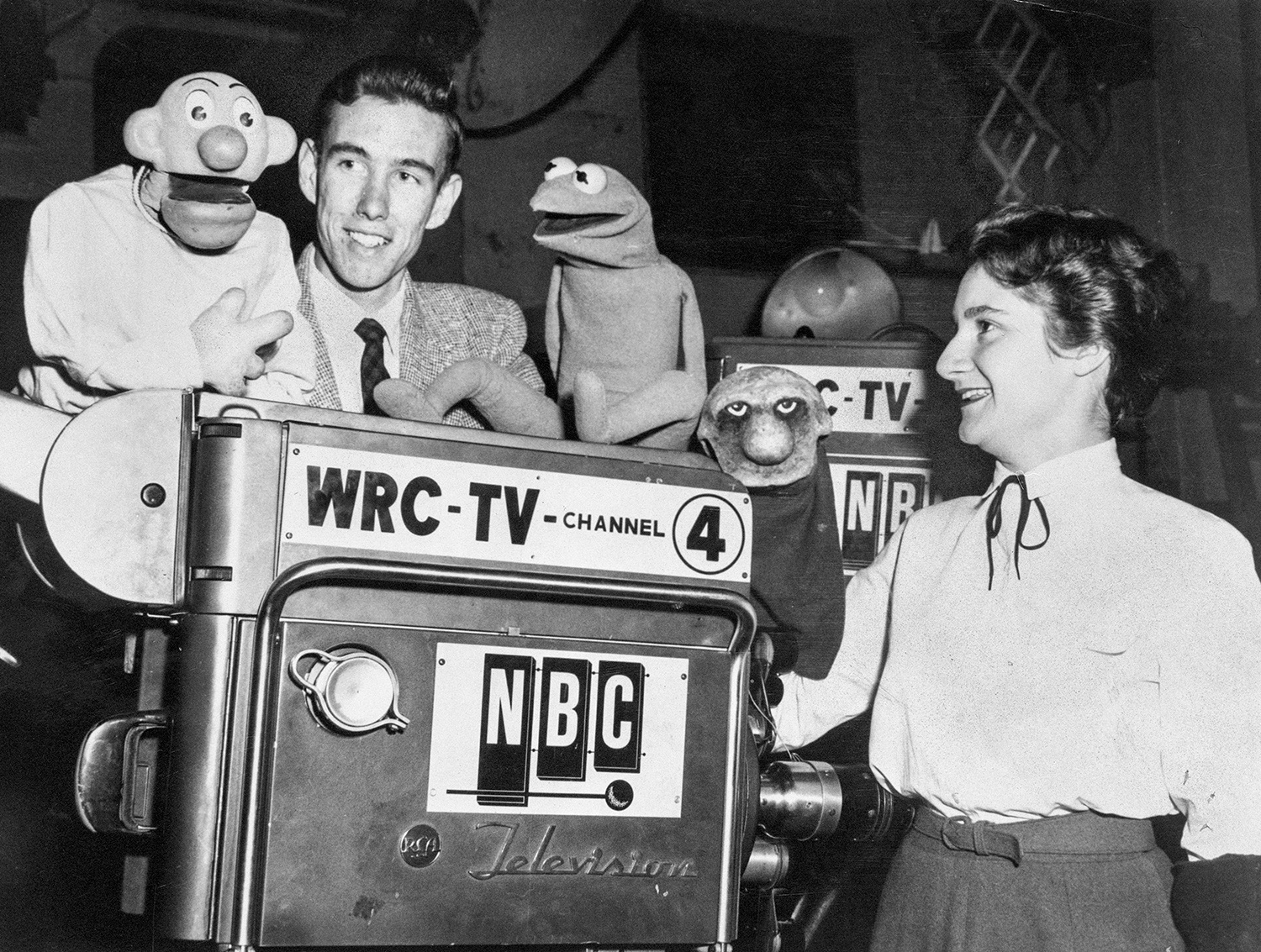
Jim Henson and Jane Nebel with the cast of their television show, “Sam and Friends,” performed and broadcast at WRC-TV, the local NBC affiliate in Washington, D.C. (1958). Left to right: Sam, Jim, Kermit, Yorick, and Jane. Photo provided courtesy of The Jim Henson Company.
This extreme fascination shaped his early career. He knew without a doubt that he wanted to work in the television industry, and he didn’t have to wait long. Shortly before graduating from high school in 1954, Henson heard that “The Junior Morning Show,” an upcoming program on Washington, D.C.’s WTOP-TV, was looking for kid puppeteers. Inexperienced with puppets but inherently creative, he and a classmate researched how to make puppets, auditioned with their own homemade designs, and were hired. While the show lasted less than a month, it jumpstarted Henson’s career by introducing him to those who would help him break into the business.
At that time, Henson did not intend to work with puppets for the rest of his career. “It was interesting and kind of fun to do, but I wasn’t really interested in puppetry then,” Henson said. However, while enrolled in a puppetry course at the University of Maryland, Henson received an offer to create and perform in “Sam and Friends,” a five-minute puppet show that would air twice per day on WRC-TV (NBC4 Washington).
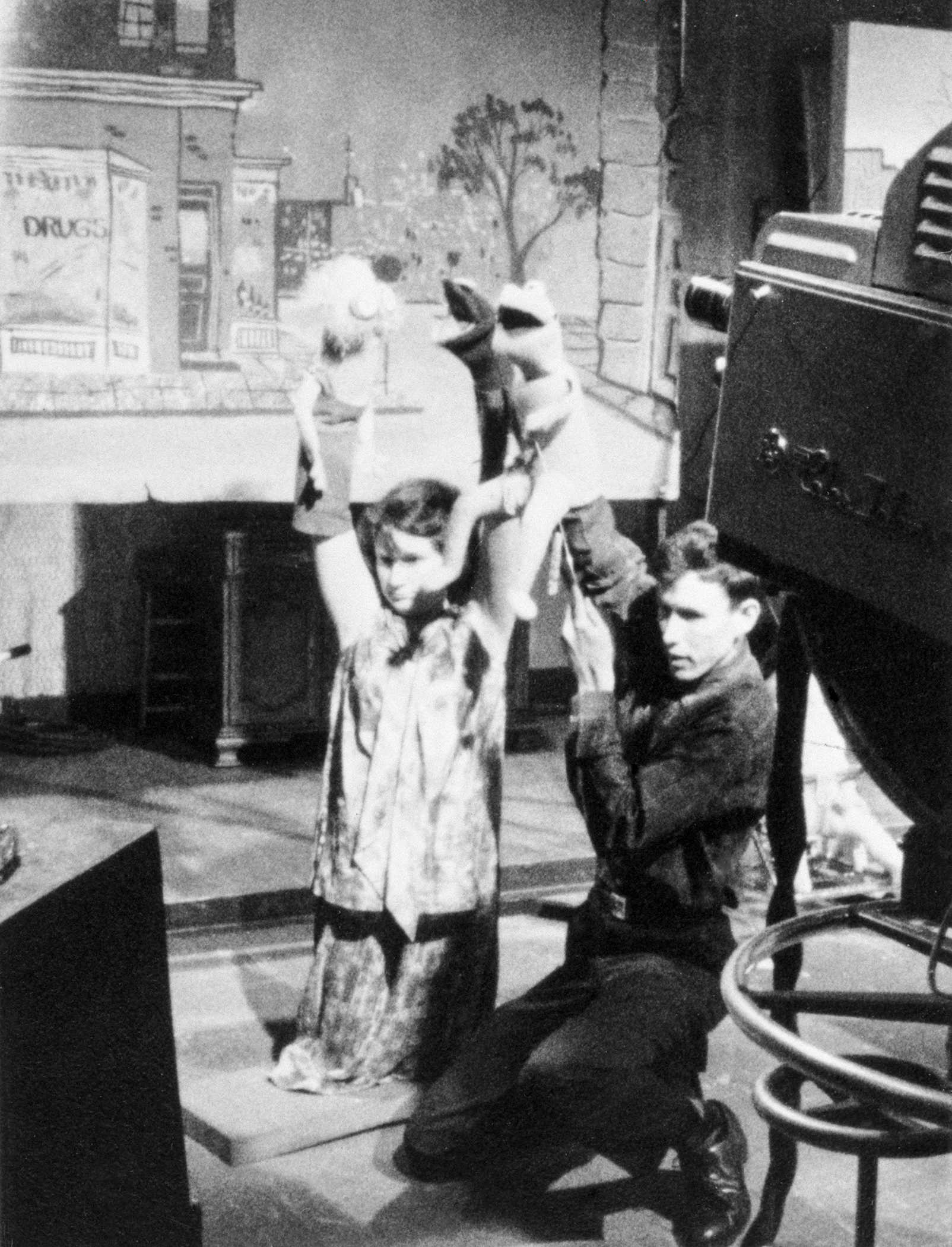
Jim and Jane Henson performing their local Washington, D.C., television show, “Sam and Friends,” at the WRC-TV studio (1960). They are using a television monitor to frame their performance for the camera, a departure from the standard use of a puppet theater, allowing for greater connection with the audience. Photo provided courtesy of The Jim Henson Company.
Also enrolled in that puppetry course was Jane Nebel, Henson’s future business partner and wife. A talented artist and performer in her own right, Jane agreed to help Jim create and perform in “Sam and Friends.” What began as a fun project turned into a strong partnership with lasting effects: “Sam and Friends” ran from 1955-1961, during which Jim and Jane founded Muppets Inc. and got married. He may not have been interested in a career in puppeteering right away, but the puppets were clearly instrumental in shaping the course of Henson’s life.
For “Sam and Friends,” Jim and Jane invented a new puppet performance technique: instead of placing the puppets on a stage in front of the camera, they used the four sides of the television screen as the puppet stage. This meant there were no barriers between the puppets and the camera. If the puppet needed to exit stage left, the puppeteer simply moved it to the left out of the camera’s view and out of view to the audience. While performing, the puppeteers could adjust their performances in real-time by watching their actions on monitors that Jim and Jane placed throughout the studio. This method brought a remarkably personal touch to their puppet shows. As Jane put it, “You’d perform but you’d also be the audience … that’s a big difference, because the people at home watching are seeing a very intimate, internal thing that’s happening with [the] performer.”
Kermit is one of the best-known Muppets. He debuted as part of the “Sam and Friends” cast in 1955. Using half of a ping-pong ball for each eye, Henson resourcefully sewed the first Kermit together from his mother’s coat and an old pair of blue jeans. Because Kermit is a Muppet classic, you might think he would have garnered Jim and Jane their first patent. Surprisingly, however, their first patent was for a different puppet known as Wilkins, who was part of the puppet duo they created to advertise Wilkins Coffee from 1957-1961.
U.S. Design Patent No. 186,119 for Wilkins was issued to Jim and Jane on September 15, 1959, for a “puppet doll or similar article.” Kermit and the puppet in the patent drawing share similar features, including the same happy grin and separated fingers, but Wilkins is still distinctly unique. U.S. Design Patent No. 186,120, issued on the same day and also for a “puppet doll or similar article,” featured a more troubled-looking puppet known as Wontkins. Wontkins appeared alongside Wilkins in the very short, comedic, and dark Wilkins Coffee commercials Henson created. The puppets live up to their names: Wilkins will drink the coffee while Wontkins won’t.

Jim Henson and Jane Nebel received their first patent, U.S. Design Patent No. 186,119, on September 15, 1959. This puppet became known as Wilkins.
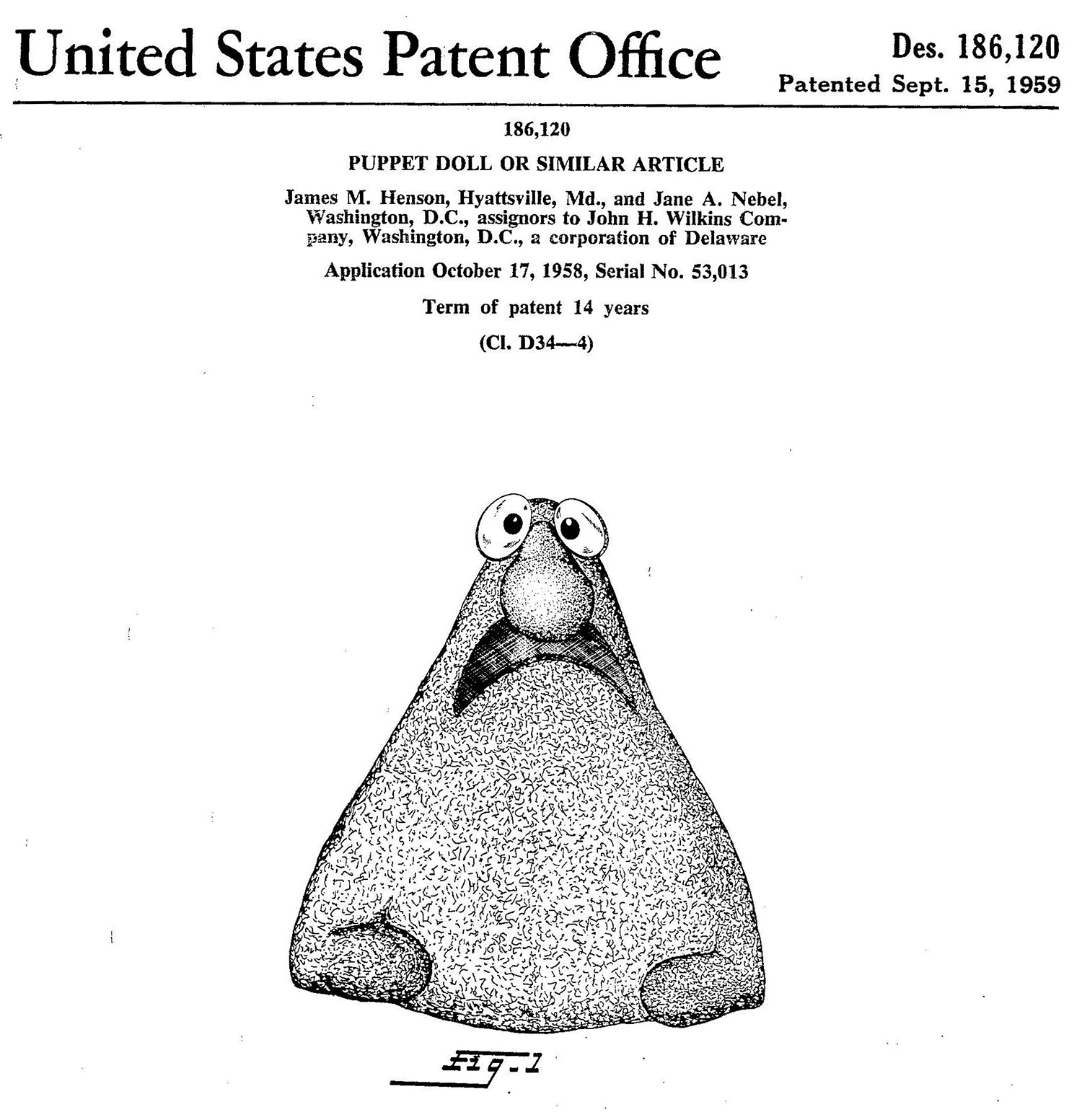
U.S. Design Patent No. 186,120 was issued to Jim Henson and Jane Nebel on September 15, 1959. This puppet became known as Wontkins.
In addition to performing on “Sam and Friends” and in commercials, Henson and his puppets started appearing as regular guests on national television shows, including the “Today” show. In 1963, Jim and Jane moved to New York City and continued to expand their business. Over the next few years, they hired additional puppeteers, puppet builders, and writers. Henson also ventured into filmmaking without the Muppets, producing short films such as “Time Piece,” which was nominated for an Academy Award in 1966. Around the same time, Henson successfully launched Rowlf the Dog, a Muppet, to stardom as a regular on “The Jimmy Dean Show.” By the time the Children’s Television Workshop needed a puppet creator for their upcoming show—eventually named “Sesame Street”—it was only natural they would ask Henson.
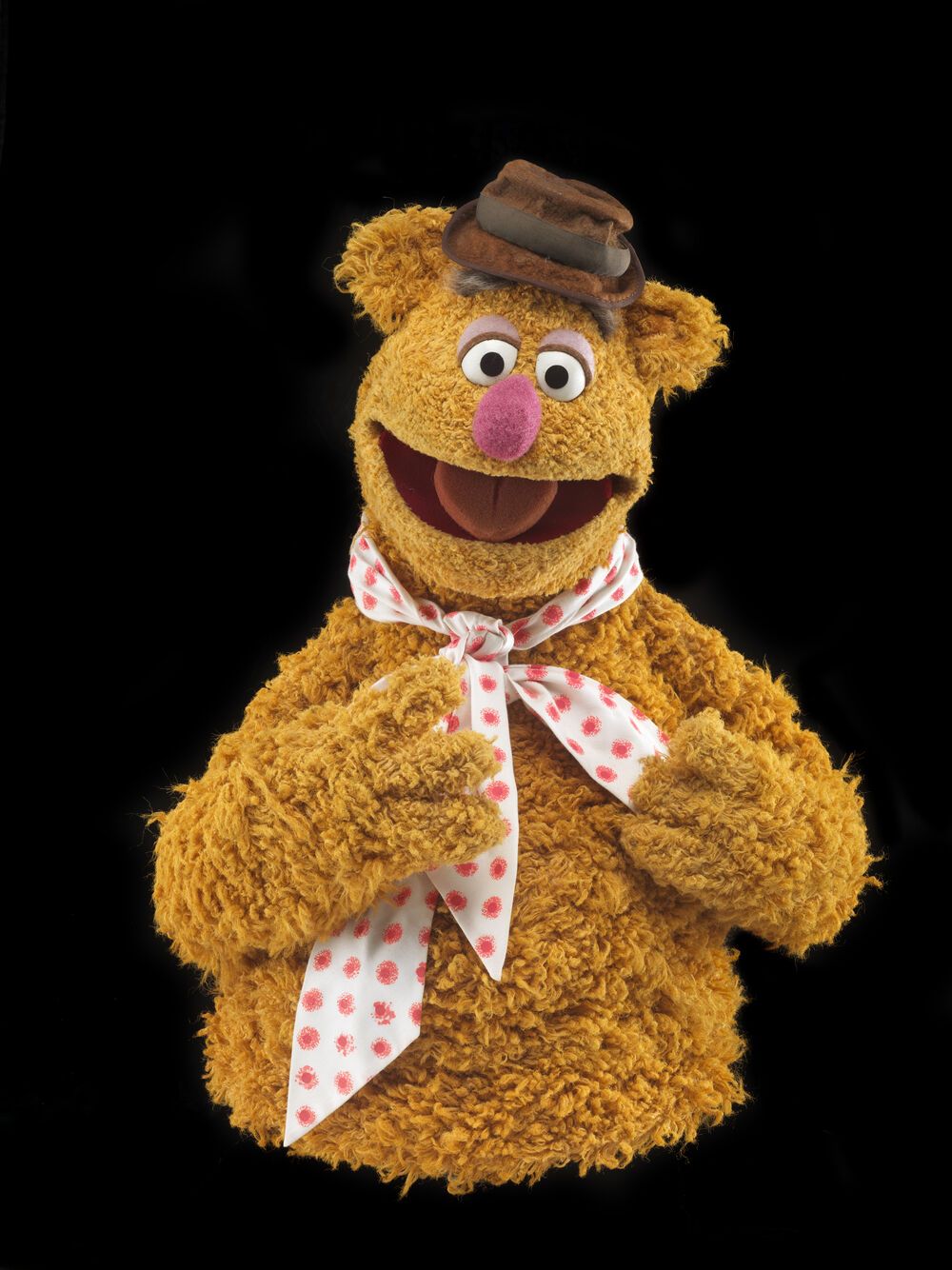
Henson created the Fozzie Bear puppet for “The Muppet Show,” which ran from 1976-1981. Fozzie, a Muppet comedian, was originally performed by Frank Oz, a puppeteer who regularly collaborated and performed with Jim Henson. Photo courtesy of The National Museum of American History.
“Sesame Street,” where many of the most recognizable Muppets came to be, first aired in 1969. Henson’s puppets were integral in making “Sesame Street” a relatable and engaging television program designed to educate children, with an emphasis on diversity, tolerance, and kindness. “Kids are going to watch television anyhow,” said Henson. “Why not put something on television that’s good for them?” This show is also filled with intellectual property protections—specifically, trademarks. Each of Henson’s well-known creations has a registered trademark, including Big Bird, Cookie Monster, and Oscar the Grouch, to name just a few. As he worked to bring his designs to life for the show, Henson also knew how important it was to protect his ideas. His company continued to prioritize intellectual property protection, and many of the trademarks remain active today. Even his name was registered as a trademark in 1979.
Despite the ongoing success of “Sesame Street”—which had won three Emmys by 1973—and the steadily increasing popularity of the Muppets, Henson had a lingering aspiration that was only growing stronger. His long journey to “The Muppet Show” perhaps best represents his persistent dedication to promoting his ideas and seeing them succeed. Believing they could do more than entertain children, Henson wanted the Muppets to regularly host their own prime time variety show. He knew this would make for interesting and entertaining television. The problem? Finding a network that agreed.
Though he first started pitching this idea in 1968, it did not gain traction until 1973, when ABC agreed to air “The Muppet Valentine Show,” a Valentine’s Day special that starred Mia Farrow as its celebrity guest. Airing on January 30, 1974, the special was considered a success, and it led to the production of a pilot for “The Muppet Show,” which aired on ABC in early 1975. That program also received positive feedback, but ABC chose not to pick up the show. Undeterred, Henson soon pitched the idea to CBS by having Kermit host a humorous reel filled with footage of successful Muppet moments, including interactions with celebrities such as Julie Andrews, Cher, and Mia Farrow. The reel mimicked what Henson hoped the format of “The Muppet Show” would be. Still, CBS declined.
Fortunately, Henson had traveled to London and been a guest on celebrity Tom Jones’s variety show in 1971. There, Henson met producers from ITC, Lord Lew Grade’s television company, performed his strongest bits, and made a lasting impression. When the major American networks passed on “The Muppet Show” four years later, Grade did not. Filmed and produced in England, the first episode of “The Muppet Show” premiered in New York in the fall of 1976. The show ran for five seasons and led to the production of multiple Muppet movies.
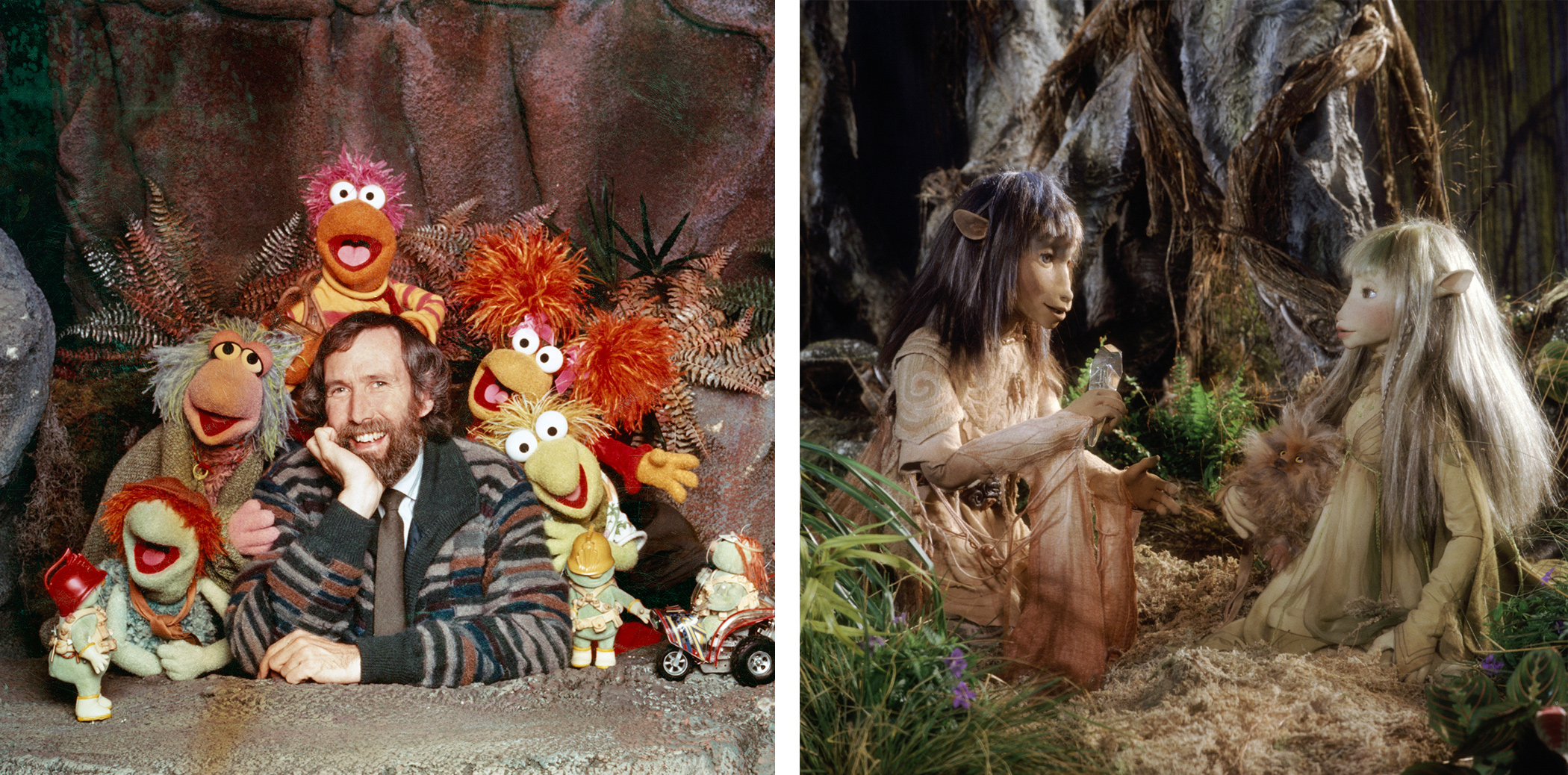
Left: Henson poses with the Doozers and some of the Muppets from his popular TV show "Fraggle Rock," including (left to right) Boober, Mokey, Gobo, Red, and Wembley. "Fraggle Rock" ran from 1983-1987. Photo courtesy of Hulton Archive/Moviepix via Getty Images. Right: Henson developed a strong interest in animatronics and became a pioneer in the field. He created animatronic creatures Jen, Kira, and her pet Fizzgig for the fantasy movie "The Dark Crystal" (1982). Photo courtesy of Murray Close/Moviepix via Getty Images.
For the rest of his life, Henson continued to create and broaden his entertainment scope. In addition to producing multiple television shows featuring Muppets, including “Fraggle Rock,” Henson was also a pioneer in animatronics. In 1979, he founded Jim Henson’s Creature Shop, a company devoted to creating unique characters by infusing puppetry with technology. The company’s creations are still made and used regularly in the entertainment industry, from television and film to live events. From 1979-1982, Henson designed animatronic characters for “The Dark Crystal,” a fantasy movie that he also wrote and co-directed. Not long after, he developed creatures for his fantasy film called “Labyrinth,” which was produced by George Lucas and premiered in 1986, with David Bowie in the lead role.
Henson worked until his death from a sudden case of pneumonia on May 16, 1990, at the age of 53. His Muppets and other characters have proven to be timeless additions to the entertainment business, creating lasting memories for children and adults alike. Despite his unexpectedly short career, we still enjoy Henson’s impactful work today because of his dedication to his art and his perseverance in bringing his imagination—and his intellectual property—to life.
Credits
Produced by the USPTO’s Office of the Chief Communications Officer. For feedback or questions, please contact inventorstories@uspto.gov.
Story by Lauren Emanuel. Contributions from Marie Ladino and Eric Atkisson. Special thanks to The Jim Henson Company for providing their photos and captions. Photo at the beginning of this story by Yousuf Karsh, courtesy of the National Portrait Gallery. Photo on the USPTO homepage provided courtesy of The Jim Henson Company. Direct quotations of Jim and Jane Henson come from Brian J. Jones’s biography “Jim Henson: The Biography” (New York: Ballantine Books, 2013) and the September 29, 1969, entry of “Jim’s Red Book.“
References
Jim Henson Company. Henson.com. Accessed February 11, 2021, https://www.henson.com.
Jim Henson Company. “Jim Henson’s Red Book.” Accessed February 24, 2021, https://www.henson.com/jimsredbook.
Jones, Brian J. Jim Henson: The Biography. New York: Ballantine Books, 2013.
National Museum of American History. “Fozzie Bear Puppet.” Accessed March 8, 2021, https://collections.si.edu/search/detail/edanmdm:nmah_1444770.
National Museum of American History. “Happiness Hotel! Original Muppets Come Home to Washington.” Published May 17, 2006, https://americanhistory.si.edu/press/releases/happiness-hotel-original-muppets-come-home-washington.
National Portrait Gallery. “Jim Henson.” Accessed March 8, 2021, https://npg.si.edu/object/npg_NPG.2011.16.
Sama, Gabriela. “Can you tell me how to get to Sesame Street?” National Museum of American History. Published November 26, 2018, https://americanhistory.si.edu/blog/sesame-philanthropy.
Sweenie, Melodie. “Jim Henson creations you may not know: Wilkins and Wontkins.” National Museum of American History. Published November 23, 2015, https://americanhistory.si.edu/blog/jim-henson-creations-you-may-not-know-wilkins-and-wontkins.


